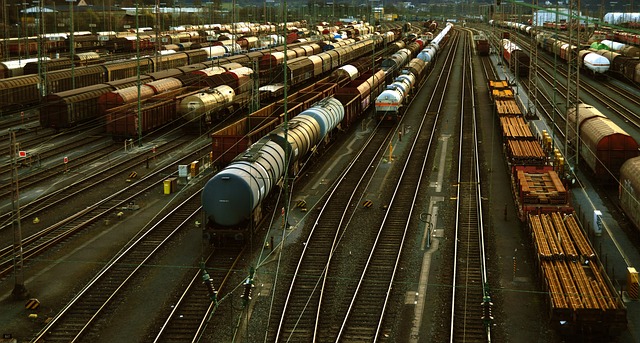The Lane County rail industry emerged as a driving force in the region's economic development during the late 19th century, thanks to pioneers who constructed railroads connecting Oregon and the nation. This infrastructure facilitated trade of local resources like timber and agriculture, attracted migrants, and transformed small towns into bustling hubs. The Oregon & California Railway, initiated in 1867, played a pivotal role, revolutionizing trade and boosting local economies. The industry's resilience stems from engineers' tireless work spanning generations, evident in the region's intricate transportation landscape. Labor movements in the early 20th century improved working conditions and workers' rights, leaving a lasting impact on both the Lane County rail industry and broader labor rights across the nation.
Explore the rich history of the Lane County, Oregon railroad industry through this comprehensive guide. From its humble beginnings to becoming a vital economic backbone, the region’s railway network has been shaped by pioneering railroads and unsung engineers. This article delves into key eras, including the transformative impact of the Oregon & California Railway, labor movements, and strikes that defined the county’s industrial landscape. Discover how these events and influential figures forever changed Lane County’s rail industry.
- Pioneer Railroaders and Their Impact on Lane County's Early Economy
- The Rise of the Oregon & California Railway: A Game-Changer for Local Communities
- Unforgotten Engineers and Their Contributions to the County's Railroad Infrastructure
- Labor Movements and Strikes: A Look at Workers' Struggles in Lane County Railyards
Pioneer Railroaders and Their Impact on Lane County's Early Economy

Lane County’s early economic development was significantly shaped by its pioneering railroaders and the burgeoning rail industry. The construction of railroads in the late 19th century connected Lane County to the rest of Oregon and the broader nation, fostering growth and opening doors for trade and commerce. These trailblazing individuals not only played a crucial role in laying down the tracks but also contributed to the county’s transformation into a bustling hub.
The impact of these pioneer railroaders was multifaceted. They facilitated the transportation of goods, such as timber, agricultural produce, and mineral resources, which boosted local industries and attracted businesses. The improved connectivity also encouraged migration, as people from all over were drawn to Lane County, seeking new opportunities and a better life. This influx of settlers further fueled the county’s economic expansion, leaving an indelible mark on its history and shaping its future prospects in the world of Lane County rail industry.
The Rise of the Oregon & California Railway: A Game-Changer for Local Communities

The Oregon & California Railway, established in 1867, marked a significant turning point for Lane County and its surrounding regions. This ambitious project aimed to connect the Pacific Coast with the interior of the state, fostering economic growth and transforming local communities. The railway’s construction brought hundreds of workers, creating jobs and attracting diverse talent to the area. It facilitated the transportation of goods, especially timber and agricultural products, revolutionizing trade and opening new markets for Lane County farmers and lumberjacks.
The impact was profound; small towns along the route flourished as they gained access to broader networks and resources. This era witnessed the rise of bustling rail hubs, fostering a sense of connectivity and unity among previously isolated communities. The Oregon & California Railway’s influence extended beyond economic benefits; it played a crucial role in shaping social dynamics, enabling migration, and facilitating cultural exchanges that left an indelible mark on Lane County’s history.
Unforgotten Engineers and Their Contributions to the County's Railroad Infrastructure

In the heart of Oregon, Lane County’s railroad industry has left an indelible mark through the tireless efforts of its engineers. These unsung heroes played a pivotal role in shaping the county’s transportation landscape, ensuring efficient connectivity and fostering economic growth. Their contributions extend far beyond simply laying tracks; they include designing innovative systems, implementing cutting-edge technologies, and overcoming vast logistical challenges to create a robust rail network that continues to serve the region.
From the early pioneers who carved through rugged terrain to establish vital routes, to the modern-day engineers who maintain and enhance the existing infrastructure, their work has facilitated the seamless movement of goods and people across Lane County. Their legacy is evident in the intricate engineering marvels that still traverse the county today, serving as a testament to their skill, perseverance, and dedication to the advancement of the local rail industry.
Labor Movements and Strikes: A Look at Workers' Struggles in Lane County Railyards

In the history of the Lane County railroad industry, labor movements and strikes have played a significant role in shaping working conditions and workers’ rights. The early 20th century saw numerous strikes across various railyards in the county, driven by low wages, long hours, and unsafe working environments. These struggles were pivotal moments for the labor force, who united to demand better treatment and fairer compensation.
Organized labor unions, such as the United Transportation Union (UTU) and the Brotherhood of Locomotive Engineers (BLE), emerged as powerful forces in these protests. Their efforts led to improvements in wages, working hours, and safety protocols, leaving a lasting impact on the Lane County rail industry. These strikes not only brought attention to the harsh realities faced by railroad workers but also set precedents for future labor rights movements across the nation.














